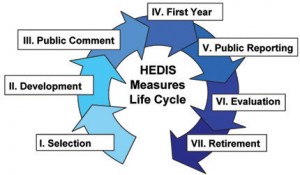NCQA published annual report showing increased rates of screening for most of its HEDIS quality measures and medical laboratory testing often plays a role in these screening activities
For almost a decade now, clinical laboratories and pathology groups have been asked by many private payers to provide laboratory test data for a number of clinical services. In turn, these private health insurers annually submit this data to the Healthcare Effectiveness Data and Information Set (HEDIS) program managed by the National Committee for Quality Assurance (NCQA).
Although their medical laboratories regularly feed this data to payers, few pathologists or lab administrators track how HEDIS data is used by NCQA. Thus, it is useful to know that, over the years, HEDIS data provides evidence that better utilization of certain clinical laboratory tests by physicians directly contributes to measurable improvements in patient outcomes across the United States.
Some HEDIS Measures Incorporate Medical Laboratory Testing in Care Protocols
Each year, HEDIS reporting requirements are expanded to cover additional medical conditions. The list of reporting measures now includes quite a few diseases and health conditions for which medical laboratory testing is essential. Some of the HEDIS’ Effectiveness of Care measures that can involve clinical laboratory testing currently include:
- lead screening for children;
- appropriate testing for children with pharyngitis;
- breast and cervical cancers, and chlamydia screenings for women;
- osteoporosis testing in older women;
- cholesterol management for patients with cardiovascular conditions;
- control of high blood pressure;
- comprehensive diabetes care;
- persistence of beta-blocker treatment affiliated with heart attack; and,
- disease monitoring for anti-rheumatic drug therapy.
Last fall, when the NQCA published its “2011 State of Health Care Quality” report, it contained good news. That’s because, for this most recent year, 23 of the 32 HEDIS Effectiveness of Care measures demonstrated clear trends of improvement.

When NCQA develops HEDIS measures, it follows the progression shown in the diagram above. A number of important HEDIS measures involve health conditions which require physicians to incorporate clinical laboratory testing when screening, diagnosing, and treating their patients. (Graphic from NCQA.org)
Gains in colorectal cancer screening are a good example. Between 2009 and 2010, screening rates for HEDIS-reporting commercial HMOs climbed by almost 2%, reaching a rate of 62.6%. Similar gains occurred for Medicare HMOs.
It is a similar story for HEDIS measures relevant to heart disease. Performance on six heart-related measures improved in the four years that these measures held their current specifications. Taken collectively, another five heart-related quality measures improved by almost 3%. These steady gains confirm that what gets measured gets improved, especially when measurement becomes a habit that health insurers sustain.
Clinical laboratory managers and pathologists know that physicians are ordering more HbA1c tests as part of diabetes screening and management. Back in 1999, when HEDIS instituted a suite of diabetes measures, HbA1c testing was included. The screening rate for diabetes has risen steadily over the past 11 years. In 1999, it was 75%. In 2010, it approached 90% for commercial HMOs. Similar gains have been seen across HMOs, PPOs, and product lines, with private Medicare plans performing best. NCQA’s outcomes include “intermediate outcome measures” that reflect test results, and capture cholesterol control, blood pressure control, and blood sugar.
Health Insurers Are Paying Attention to Their HEDIS Scores
“Plans are waking up to the fact that there are so many opportunities to improve,” observed Margaret O’Kane, President of NCQA. She pointed out that more insurers are focusing on areas such as chronic disease management and are working with providers to curb rates of preventable hospital readmissions.
HEDIS is becoming increasingly important for private health plans.
Dr. Michael Sherman, MD, MBA, Senior Vice President and Chief Medical Officer of Harvard Pilgrim Health Care, a health benefits company in Wellesley, Massachusetts, said that those plans choosing not to participate in two objectives outlined by NCQA—Medicare payment reform and the push for more transparency—will be “an endangered species.” Sherman made those comments in a story published by ModernHealthcare.
Pathologists and clinical laboratory managers may both cheer and groan when they learn that efforts are underway to move HEDIS toward a fully-digital program. The cheers will come because a digital program will make it easier for medical laboratories to report lab test data used in HEDIS reporting. The groans are a result from recognition that time and money will be required if medical laboratories are to build the electronic interfaces necessary to transmit this lab test data out of their laboratory information systems (LIS).
NCQA is working closely with the Office of the National Coordinator for Health Information Technology, the Centers for Medicare and Medicaid Services, and the National Quality Forum to translate HEDIS measures into electronic formats. The drive to adopt electronic health record (EHR) systems will reinforce this effort.
—By Carren Bersch
Related Information:
22007-2010 NCQA State of Health Care Quality Reports
THE DARK REPORT: Integration of Clinical Care and the Lab Industry



